Are you eager to harness the power of social media to elevate your brand?
Do you aspire to engage your audience effectively and solidify your brand’s online presence?
If your answer to these questions is a resounding ‘yes,’ then you’re in the right place.
With over 56.8% of the world’s population active on social media, it becomes a vital asset for your business to connect with your potential target market and achieve your marketing goals.
In this comprehensive guide, we’ll explore the intricacies of social media management. We’ll navigate its complexities, tackle its unique challenges, and uncover the opportunities it presents for businesses and agencies.
Whether you’re a seasoned pro or a newbie, we’ll arm you with the knowledge and strategies you need to master this crucial aspect of digital marketing.
So, let’s dive into the nitty-gritty aspects of social media management without further ado.
What Is Social Media Management?
Social media management is a multifaceted process that leverages various platforms to foster audience growth and drive revenue. It’s a comprehensive approach beyond merely posting updates on your company’s social media profiles. It’s about creating, scheduling, analyzing, and engaging with content across various social media platforms.
Social media management involves:
- Crafting a Social Media Strategy: This is your roadmap for all your social media activities. A well-crafted strategy stems from understanding your brand’s goals, identifying your target audience, and determining the type of content that resonates with them.
- Creating and Posting Social Media Content: The heart of social media management is engaging content that aligns with your brand’s voice and values. It’s about developing content that your audience will find valuable and scheduling it for times when your audience is most active.
- Creating and Managing Social Media Ads: Social media advertising is a powerful tool that extends your reach beyond your existing followers. It involves crafting compelling ad content, targeting specific audience segments, and managing ad budgets and campaigns.
- Engaging with Followers and Influencers: Social media is all about interaction. Engaging with your audience through comments, messages and mentions, and building relationships with relevant influencers can amplify your brand’s reach.
- Analyzing and Reporting on Metrics: Measuring the effectiveness of your social media activities is crucial. By tracking KPIs such as engagement rate, follower growth, click-through rate, and conversion rate, you can gain insights that help refine your strategy.
Social media management is pivotal for all – be it a small business, a large corporation, or an individual looking to build a personal brand. It can be handled by a dedicated in-house team, a single social media manager, or outsourced to freelancers or marketing agencies.
Now, let’s explore why social media management is indispensable for your brand.
Why Is Social Media Management Important?
Social media management has become a pivotal aspect of business strategy. Platforms such as Facebook, Twitter, and Instagram offer many opportunities for brands to connect with their audience and amplify their reach.
And the best part? These platforms are free to use.
Consider this: the global average internet penetration rate was roughly 64.6%. It translates to billions of potential customers engaging with brands in various ways, from viewing content and clicking ads to asking questions.
Take Nike, for instance. With a whopping 302 million followers on Instagram, their posts regularly reach a vast audience, generating significant engagement through likes, comments, and shares.
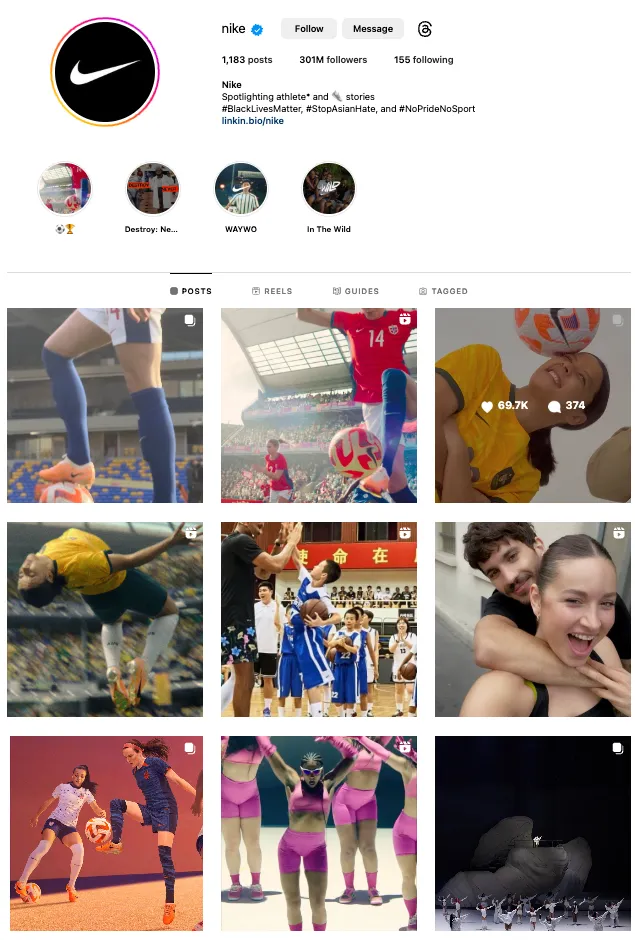
This level of visibility and interaction boosts Nike’s brand awareness and drives traffic to their online and physical stores, leading to increased sales.
However, to truly leverage the power of these platforms, brands need a structured approach to social media management. Inactive social media profiles, poor-quality content, and lack of engagement can create a negative brand image, discouraging potential customers.
Social media management is more than maintaining an active presence on social media platforms. It’s about taking actionable steps to manage multiple social media handles.
And how do you do that?
How to Do Social Media Management?
To thrive in social media management, one must be adept in various areas. It’s like orchestrating a symphony, ensuring each section plays in harmony. From choosing the right platform to analyzing feedback, every aspect is crucial.
Here’s a deeper dive into six essential strategies for effective social media management:
1. Select the Ideal Social Media Platform for Your Brand
Choosing social media platforms for managing your brand’s online presence is a critical decision. Each platform has unique features, audience demographics, and content strategies that can make it more suitable for certain brands.
Here’s a breakdown of some popular platforms and how to leverage them effectively:
a. Facebook
With the largest user base among social media platforms, Facebook is a must in your brand’s digital toolkit.
It’s not just about the numbers, though.
Facebook has a diverse demographic range – you can reach different age groups and interests.
But how do you take advantage of this?
Start with diverse content types. Text posts, images, videos, live streams – mix it up to keep your audience engaged.
Next, tap into Facebook’s detailed targeting options for ads. It allows you to reach the audience most likely interested in your brand.
Don’t forget about Facebook Marketplace, a feature that lets you sell products directly on the platform.
Lastly, consider creating a Facebook Group. It’s a space for your audience to connect over shared interests, fostering a sense of community around your brand.
b. Twitter
If your brand thrives on real-time engagement and staying updated with current events, Twitter should be your primary platform. It’s not just about 280-character tweets; it’s a global stage where news breaks first, and trends take shape.
With its daily active user count in the millions, your brand’s messages have the potential to resonate with a vast audience, from casual users to industry influencers.
Moreover, Twitter’s integration capabilities mean your tweets can amplify other aspects of your digital marketing, from blog post promotions to live event updates.
Quality and relevance are paramount. Brands can share insights, engage in trending conversations, and even host Twitter Spaces for live audio discussions. Encourage interactions through retweets, likes, and replies. With the evolving algorithm, leveraging the right hashtags and keywords in your tweets ensures they reach the intended audience.
c. Instagram
Instagram is all about visuals; if your brand has a strong visual appeal and can tell compelling stories, this platform is meant for you.
But don’t just limit yourself to posting a pretty picture or video – it’s about creating an entire aesthetic that can truly represent the values and identity of your brand.
Instagram is popular among younger demographics, with 67% of U.S. adults aged 18-29 using the platform. With features like Stories, Reels, and shoppable posts, Instagram becomes a perfect platform to creatively showcase your services or products.
In other words: if your brand thrives on visual storytelling and targets a younger demographic, Instagram can help you build a strong, engaged community around your brand.
d. LinkedIn
LinkedIn is reshaping the way brands engage with professionals and industry peers.
LinkedIn has over 930 million members and is the world’s largest professional network, making it a hub for B2B interactions and thought leadership. It’s a platform where brands can establish authority and credibility in their respective industries.
So, why should your brand be active on LinkedIn?
LinkedIn offers a unique space to connect with professionals, decision-makers, and industry leaders. If your brand aims to establish thought leadership, foster B2B relationships, or hire top talent, this is the place to be.
One of the platform’s strengths is its content diversity. From articles and case studies to webinars and infographics, brands can share content that provides value to their professional audience.
Engaging with industry trends, participating in relevant group discussions, and leveraging LinkedIn Ads can significantly enhance your brand’s visibility and credibility on the platform.
e. YouTube
If your brand’s content strategy revolves heavily around videos, YouTube is where you must be.
It’s not just a social media platform; it’s also the second-largest search engine globally, with more than two billion logged-in users per month. This means your content has the potential to be discovered by a large audience who are actively looking for entertainment or information.
Moreover, YouTube videos can be integrated fairly easily into other parts of your digital marketing strategy, such as a website or email campaign.
Ensure you produce high-quality content.
Brands can create tutorials, product reviews, behind-the-scenes videos, and more. Ask your audience to engage with you through the comments in these videos. Also, do not forget the importance of SEO here as well. Use relevant keywords in your video titles, descriptions, and tags to help your content get discovered.
f. TikTok
TikTok is revolutionizing the way brands connect with younger audiences.
With over 1.06 billion active users worldwide and 60% of its U.S. audience aged between 16-24, TikTok offers an unparalleled opportunity to reach a younger, highly engaged audience. It’s known to be a platform where users and brands can showcase their creativity.
So, why should you consider this platform?
TikTok offers an unparalleled opportunity to reach a younger, highly engaged audience, especially if your brand is bold, trendy, and not afraid to think outside the box.
A great thing about this platform is that even as a brand with a small following, you have a high possibility of going viral thanks to its unique algorithm which prioritizes content discovery. TikTok can be a game-changer for your brand’s social media presence if you can tap into the platform’s trend-driven nature and produce entertaining, original content.
g. Pinterest
Pinterest is a leading platform for visual inspiration, where users curate their aspirations, from dream homes to travel destinations.
With over 400 million monthly active users, a staggering 70% of whom are under 34 years, Pinterest offers a unique blend of discovery and intent.
Beyond being a gallery of captivating images, Pinterest offers brands a unique space to influence purchasing decisions through compelling visuals right at the discovery stage. To harness its potential, brands should craft pins that resonate with users’ interests, ensuring content is both aspirational and keyword-optimized for enhanced discoverability.
So, now we know how to select the ideal platform. What’s next? It’s time to create a content strategy tailored to these platforms.
2. Craft Engaging Social Media Content
The digital landscape is a mosaic of various social media platforms, each with unique characteristics and audience demographics. To truly resonate with these diverse audiences, it’s imperative to tailor your content to each platform’s specific nature and strengths.
Let’s delve into the “how” of it:
a. Facebook
Facebook is a dynamic space for brands, offering myriad tools to foster connections. While the platform supports hashtags, their use should be minimal, unlike on Instagram or Twitter.
Instead, the emphasis should be on sharing localized, personalized content that reveals the faces behind the brand. It could be in the form of behind-the-scenes videos or how-to guides related to your product. And, to ensure your brand stands out, opt for a distinctive profile picture and banner that resonate with your brand’s identity.
Here’s how Adidas Football leverages Facebook to establish its brand identity using a distinctive profile picture and banner.

b. Twitter
Known for its quick, real-time updates and concise text, Twitter is great for brands to engage in quick, timely conversations with their audience.
The platform’s fast-paced nature makes it ideal for sharing news, updates, and quick snippets. Even the use of hashtags means greater visibility and participation in trending topics. Plus, Twitter’s interactive features, like polls and retweets, offer unique opportunities for engagement.
A restaurant could tweet their daily specials, retweet positive customer reviews, or start a poll asking followers about their favorite menu item. Here’s an example of Gusto Restaurants about their special offer.
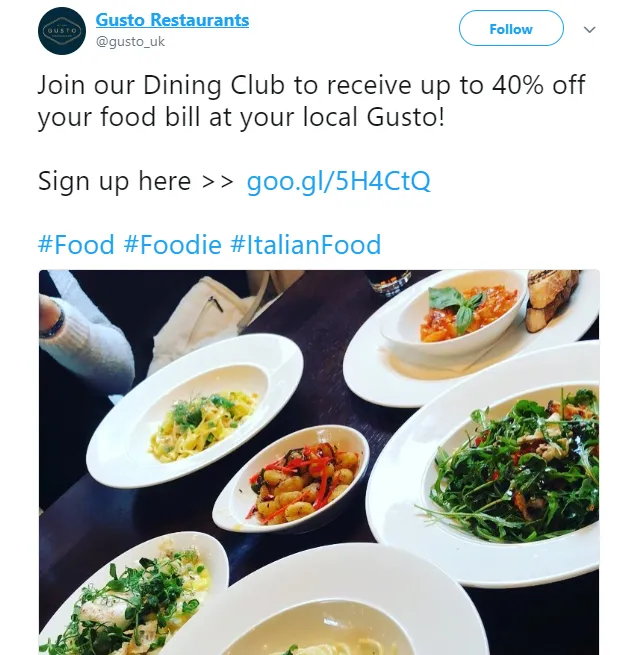
c. Instagram
Instagram is a canvas for creativity, where visuals reign supreme and authenticity drives engagement.
As you curate content, remember that every image or video is a story waiting to be told. Hashtags, more than just digital trends, serve as bridges, connecting your content to larger communities and conversations. While the main feed showcases your brand’s essence, Stories offer a fleeting glimpse into its daily life, making every post an event.
Reels, on the other hand, are your stage, where short videos come alive with music and innovation, lingering longer than Stories.
But amidst these tools, the heart of Instagram lies in genuine imagery. Beyond the filters and edits, the raw, real moments truly resonate, painting a picture of a brand as authentic as its audience.
Here’s an example of a sports brand like Nike using Instagram Reels to market content and reach millions of users.
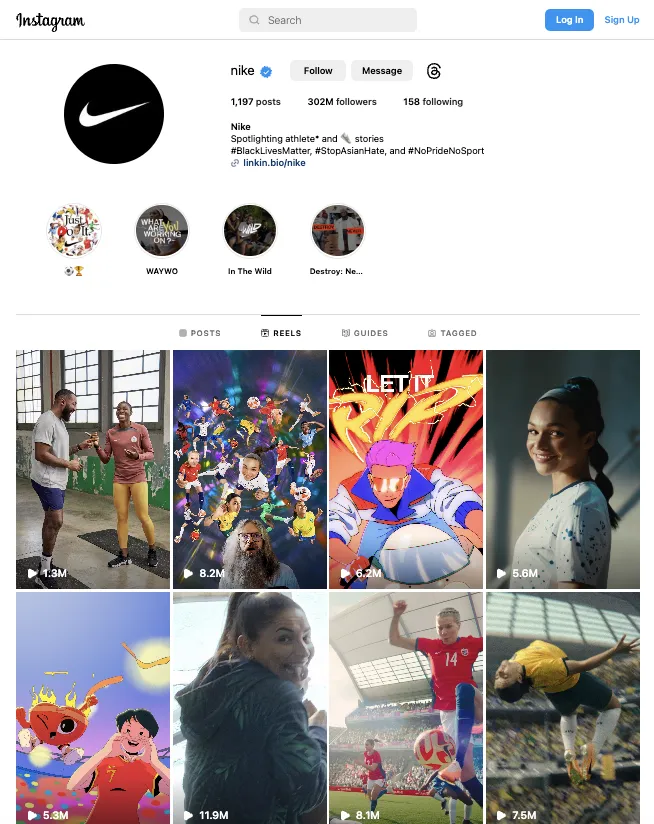
d. LinkedIn
LinkedIn is a hub for professionals, emphasizing meaningful interactions and knowledge sharing.
When crafting articles, it’s essential to tap into the platform’s publishing tool, positioning yourself as an industry thought leader. Rather than just broadcasting updates, dive deep. For instance, if you’re a tech professional, discuss the nuances of emerging trends or dissect impactful case studies.
Engaging in industry-centric groups isn’t just about participation; it’s about contributing value, sharing insights, and fostering discussions. And as you expand your network, remember: every connection is a potential relationship. Approach each with genuine interest, personalizing your introductions and focusing on mutual growth rather than just numbers.
Here’s an example of Microsoft sharing important industry insights to help sales and marketing professionals.
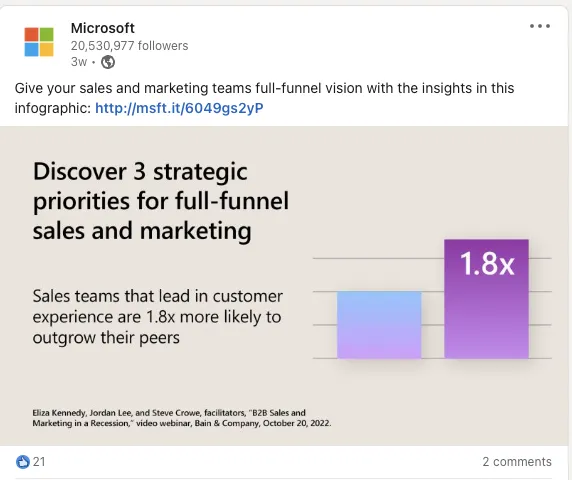
e. YouTube
YouTube, the world’s largest video platform, is a powerhouse for brands aiming to captivate audiences through video content. With its vast user base, YouTube offers a unique entertainment, education, and engagement blend. Brands can leverage this platform to showcase product tutorials, behind-the-scenes looks, customer testimonials, and more.
The key is to produce high-quality, engaging videos that resonate with your target audience. Additionally, YouTube’s algorithm favors content that keeps viewers on the platform longer, so consider creating series or longer-form content that encourages binge-watching.
Here’s an example of Red Bull, a brand that has mastered the art of storytelling on YouTube, consistently producing content that resonates with its adventure-loving audience.
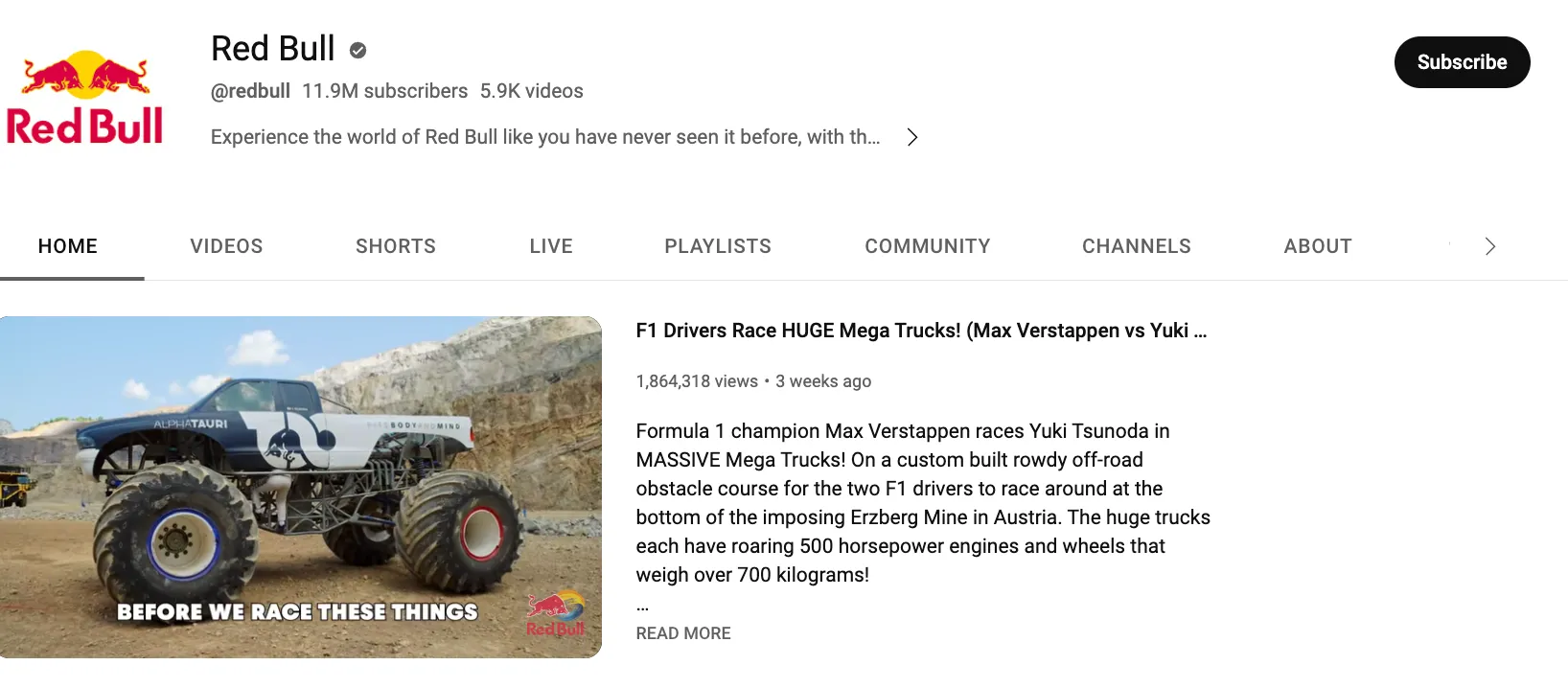
f. TikTok
TikTok, the short-form video platform, has taken the world by storm, especially among Gen Z. It’s a space where creativity and spontaneity reign supreme. For brands, TikTok offers a chance to tap into trending challenges, create viral content, and engage with a younger demographic in a fun and authentic manner.
The platform’s algorithm is known for its unpredictability, so consistency and authenticity are key. Collaborating with influencers or jumping on trending challenges can also boost visibility.
Here’s how Chipotle has effectively utilized TikTok, engaging with users through fun challenges and collaborations. It is the most followed food brand on the platform.
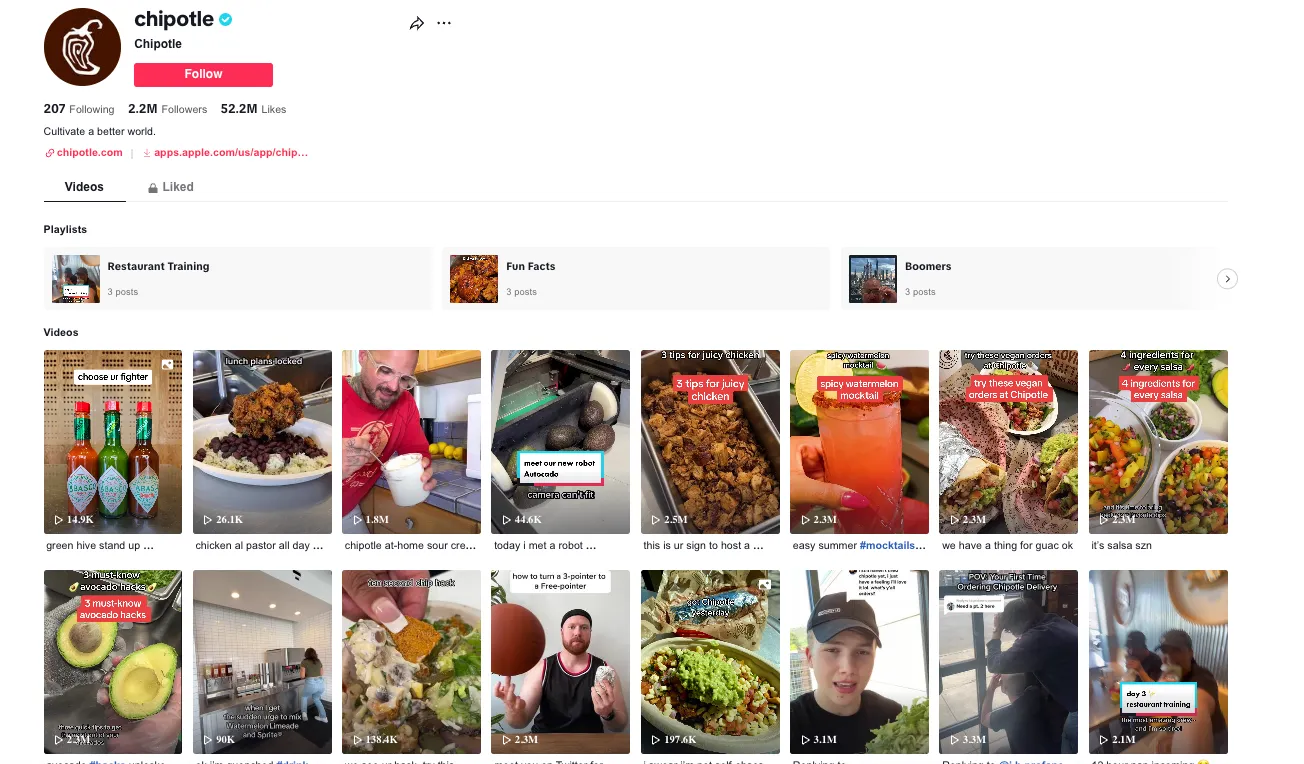
g. Pinterest
Pinterest is a visual discovery engine where users pin and organize images that inspire them, from home decor ideas to fashion trends. For brands, it’s a platform to inspire and be discovered. The pins you create can drive direct traffic to your website, making it a valuable tool for e-commerce businesses.
Creating high-quality, visually appealing pins that align with what users are searching for is essential. Using the right keywords in your pin descriptions can also increase discoverability.
Here’s an example of Etsy, which uses Pinterest to showcase unique products from its platform, driving traffic and sales.

Now, let’s move on to the next aspect of social media management: collaboration and team member management.
3. Focus on Social Media Collaboration and Team Member Management
A staggering 97% of employees believe a lack of alignment within the team impacts the outcome of a task or project. This principle holds true for your social media management as well. Whether you’re a small business or a large agency, managing social media is a team effort.
From strategizing to analyzing outcomes, every step gains momentum with cohesive collaboration. But how do you ensure that every team member is in sync, and the collaboration is seamless?
Here are some tips that you can follow:
a. Set Your Goals
Before diving into planning, it’s crucial to define your objectives. These objectives will guide the direction of your brand’s social media partnership.
A piece of advice: Avoid venturing into social media promotion without a clear objective for your brand. Doing so can be more detrimental than beneficial.
Establishing an objective from the outset clears up any potential ambiguities. Collaborative efforts on social media lose their purpose without a well-defined aim. Additionally, it unifies individuals to strive for a shared objective.
Instead of setting ambiguous objectives, consider these suggestions to craft effective social media partnership goals to enhance your team’s productivity.
- Set realistic and achievable goals
- It should support the vision or values of your brand’s social presence
- It should be measurable
- Be as specific as you can
Here’s what the process of setting goals would look like for your marketing team:
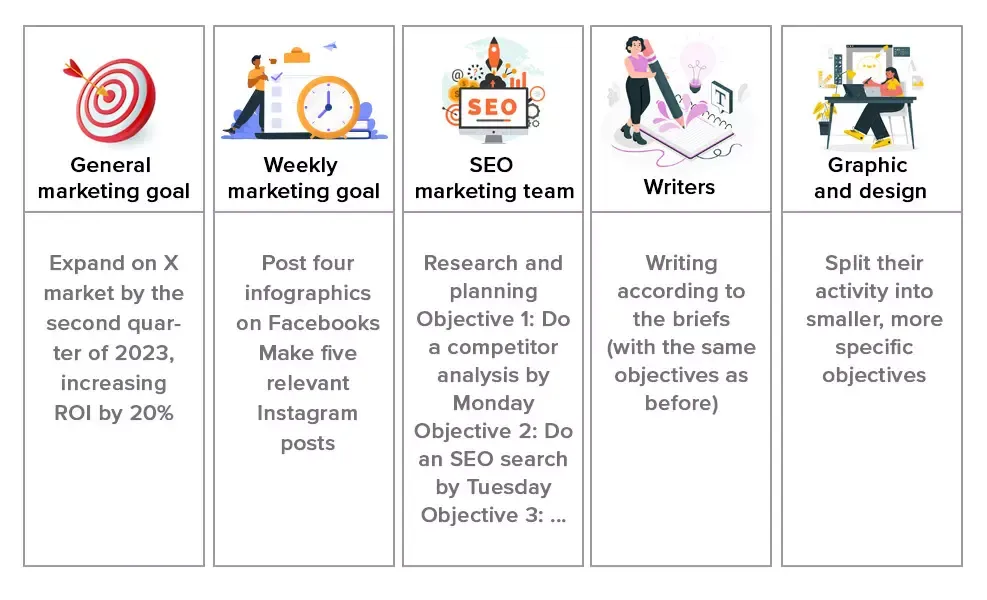
b. Prepare a Collaboration Strategy
For successful social media partnerships, fostering a culture of responsibility is key. It’s wise to allocate roles to individual team members from the beginning. Establishing and consistently enforcing guidelines ensures everyone understands their specific duties.
Never assume your team knows their roles; relying on memory isn’t enough. Instead, draft a precise strategy that delineates each person’s responsibilities.
Allocate tasks to team members based on their strengths and expertise to reduce interdependencies. By limiting these dependencies, you boost the efficiency of each member which naturally leads to heightened team productivity.
The major components of your collaboration plan will broadly include:
- Assigning roles and delegating the task
- Preparing a crystal clear timeline for each task
- Setting clear expectations
- Documenting the above three points
c. Assign Roles
The section above leads us to one essential observation:
You can’t establish a clear process for everyone unless you have precise roles for all your team members.
Usually, a marketing team that deals with social media has the following people:
- Social Media Manager, the overseer: The social media manager makes sure everyone collaborates with their team successfully. They also do general research and assign tasks.
- Content Creator, the enforcer: Content creators receive briefs, putting their creative cogs at work to research and deliver the required content.
- Community Manager, the connector. Community managers manage relationships with the community. They’re involved in communications and PR, including events and some customer service. They’re also the ears of your marketing team, using their top-notch interpersonal skills for social listening.
- Analyst, the checker: Analysts will monitor the result of your marketing team’s activities, ensuring that its endeavors are effective. Analysts provide progress reports with practical insights to reorganize a faulty campaign and plan more successful ones in the future.
d. Leverage a Social Media Calendar
Working in a team can increase the chances of overlaps and missed opportunities. A shared calendar is the glue that binds a team, ensuring everyone’s on the same page, working in harmony towards a unified goal.
You can:
- Assign Responsibilities: Clearly define who is responsible for what. Whether content creation, graphic design, or analytics, assign tasks and deadlines to avoid confusion.
- Plan for Key Dates: Be it holidays, product launches, or industry-specific events, planning ensures you’re not missing out on key engagement opportunities.
- Review and Adjust: A dynamic calendar allows for regular reviews. Analyze the performance of past posts and adjust future strategies accordingly.
- Centralized Feedback: Use the calendar as a platform for feedback. Team members can leave comments or suggestions on scheduled posts, ensuring content is refined before going live.
If you’re new to using a social media calendar, start with a basic spreadsheet. As you become more accustomed, consider investing in specialized software that offers more features. Also, hold weekly or bi-weekly meetings to review the calendar. Discuss upcoming posts, assign tasks, and gather feedback.
Most importantly, ensure every team member understands the importance of the calendar and how to use it. Regular training sessions can be beneficial.
Want to avoid the learning curve of using a spreadsheet? Might we suggest exploring SocialPilot’s calendar feature for streamlined scheduling and insights.
With our calendar, you can easily manage your content without having to learn anything complicated. This simple, easy-to-use tool gives you a bird’s view of what content is scheduled for which account. The benefit doesn’t just end at planning; it’s about strategizing for maximum impact.
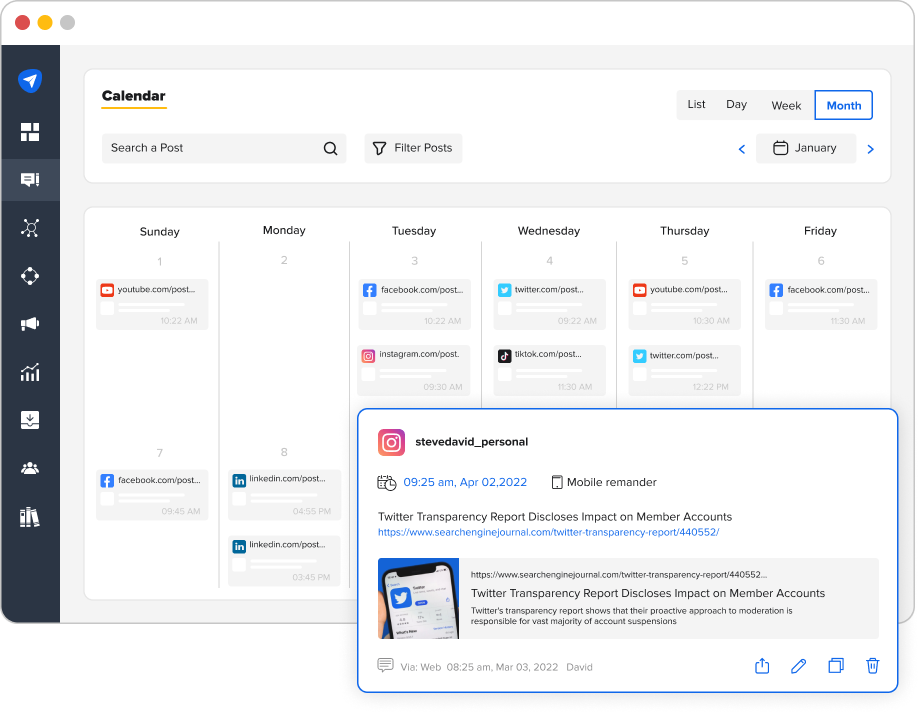
Now, let’s move on to the next crucial aspect of social media management – engagement and listening.
4. Build Relationships Through Social Media Engagement and Listening
Social media isn’t just a platform for promotion; it’s a two-way street. But how do you ensure that your brand isn’t just talking, but also listening and engaging?
Here’s how:
a. Prioritize Personalized Interactions
Every time someone comments on your post, shares your content, or even hits that like button, it’s a direct line of communication. It’s them saying, “Hey, I noticed you.”
So, how do you respond?
Avoid the trap of generic, one-size-fits-all replies. Instead, take a moment to craft a response that speaks directly to that individual. Maybe they shared a personal story in the comment or asked a question. Address that. Make them feel seen and heard.
Take a look at the following example. When a user had a query about a company offer, Starbucks addressed the situation with a personalized comment.
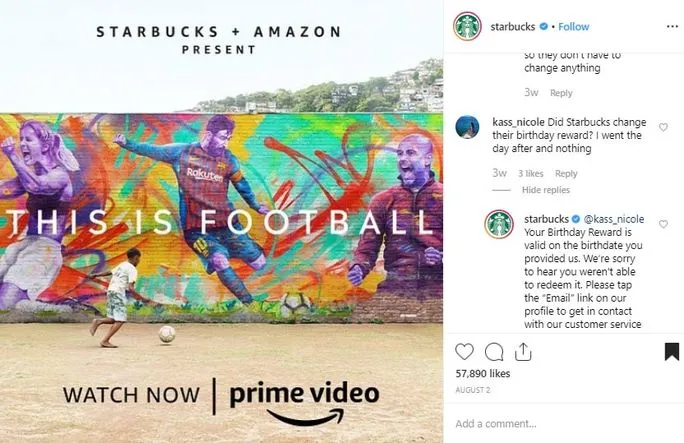
Why?
Because personalized interactions aren’t just about that one comment or user. It’s about creating an image and a brand reputation. When other users see your tailored responses, they recognize a brand that values its audience, listens, and cares. And in the long run, this fosters loyalty, trust, and a community that feels connected to your brand.
Foster a dynamic, two-way conversation with your audience using SocialPilot’s comprehensive Social Inbox.
This tool allows you to manage all your social media interactions in one place, making it easier to respond promptly and keep the conversation flowing. It’s a game-changer for enhancing engagement and building stronger relationships with your audience.
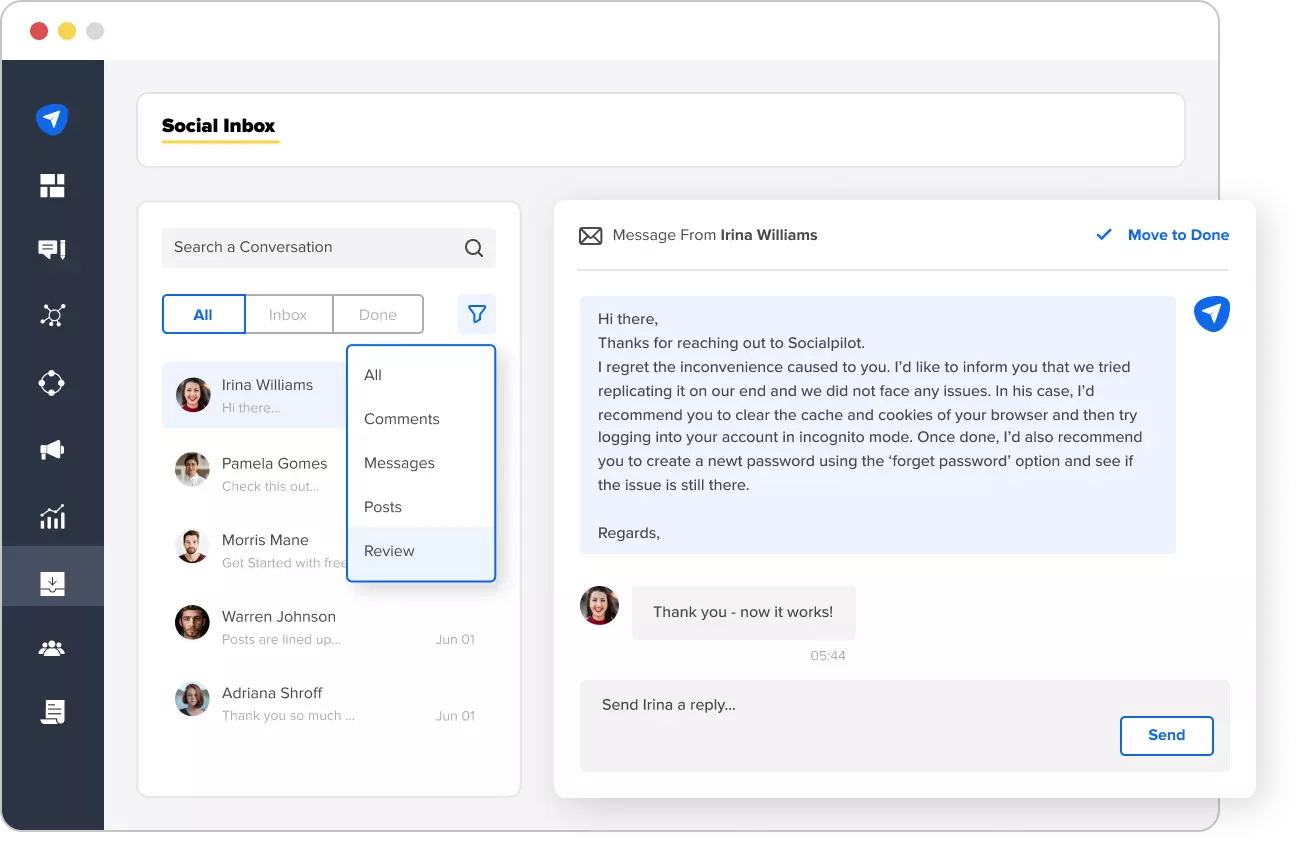
b. Monitor Brand Mentions
While direct tags are easy to spot, many discussions might fly under your radar. But here’s the thing: every mention, tagged or not, holds value.
Imagine a customer raves about your product in a tweet but forgets to tag you. Or perhaps there’s a forum where potential clients ask for recommendations, and your brand pops up. These are golden opportunities; missing out is a lost chance at engagement.
Take this example from a customer-oriented e-commerce company Zappos.
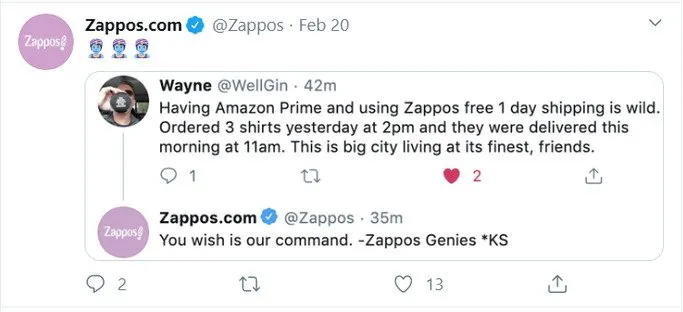
Here Zappos exhibited an excellent example of one-on-one interaction by replying to their happy customer just a few minutes after the user tweeted.
This is where monitoring tools come into play. By watching for brand mentions across various platforms, you ensure every conversation is noticed. Dive into these discussions. Address concerns, clarify doubts, or simply extend a word of thanks.
c. Learn from Real-time Feedback
Negative comments? Don’t delete or ignore. Address them.
Social media provides real-time feedback, and every criticism is an opportunity to improve and showcase your brand’s commitment to customer satisfaction.
If you run a business and put your heart and soul into it, it might be challenging to deal with the negativity. But you have to handle it strategically, otherwise, angry customers will write many negative comments to harm your brand.
Focusing on solving the root cause of the negative comments.

Here Selina, a popular beach hostel, took sincere feedback from its annoyed customer to provide better service.
Now, let’s move on to the next crucial aspect of social media management – community management.
5. Foster Authentic Connections Through Social Media Community Management
As social media evolves, so are how users engage with the content.
Today’s customers seek genuine, meaningful interaction – not just from their peers, but with the brands they support. This shift towards more intimate, authentic conversations has created opportunities for brands to create personalized social experiences.
One way to tap into this trend is through social media community management. By creating and nurturing online communities, brands can facilitate meaningful discussions, build stronger relationships, and position themselves at the heart of their audience’s social media experience.
Here are a few tips to ensure your community management efforts always hit the mark:
- Ask Questions: Encourage interaction by asking your audience for their opinions or experiences. Here’s an example of a jewelry retailer Ring Concierge using Instagram Stories to regularly communicate with the audience, often holding Q&As and having followers vote on potential new products.

- Host Competitions: Engage your community with fun contests or challenges. This could be a photo contest on Instagram or a caption competition on Facebook – the key is to make it fun and relevant to your audience. Here’s an example of the Cool Ship Technologies Contest, sponsored by The Hershey Company and administered by NineSigma.

Hershey is on a mission to devise a cost-effective, lightweight shipping solution capable of maintaining chocolate at its optimal temperature, which is 75°F or lower, for a minimum of 48 hours.
Prospective participants can readily assess whether their technology might be a suitable solution.
- Incentivize Community Behaviors: Reward active participation to encourage more engagement. A rewards program often gives regular customers perks, and a great example of this can be seen with Starbucks.
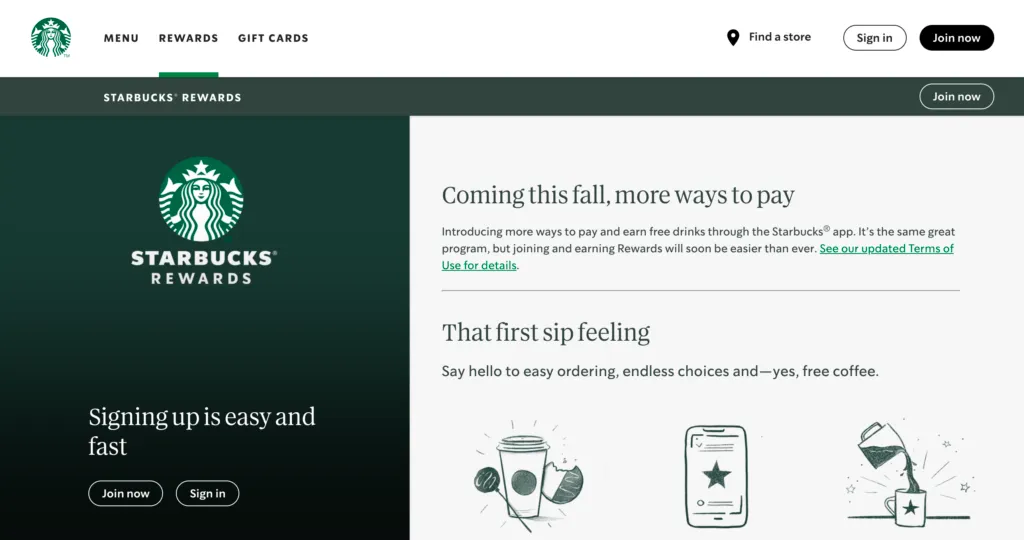
Each time a rewards member orders through the Starbucks app, they earn Stars that add up to perks, like free espresso shots or free drinks.
- Repurpose Group Content: Share popular community content on your other social channels. When repurposing content, it’s essential to always provide a link to the group, allowing users to join easily.
Let’s say your brand manages a Facebook group, but a few of your audience frequently uses Twitter. Sharing these posts on Twitter can drive target users back to your dedicated community channel.
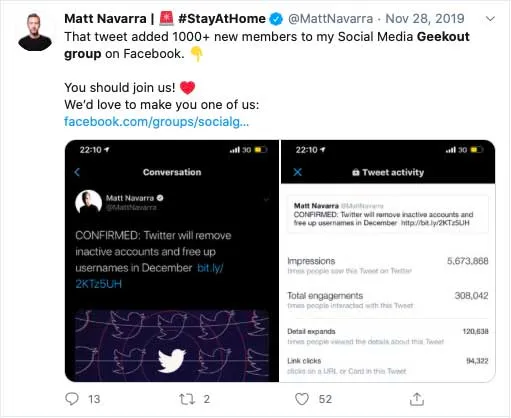
6. Use Social Media Monitoring
Monitoring and analyzing social media results is like taking the pulse of your brand’s online presence. It shows you what’s working and what isn’t, allowing you to refine your social media management strategy and continue growing.
Social media monitoring is the practice of tracking and analyzing trends, campaigns, and overall presence on social media platforms. It involves sifting through the noise to find relevant conversations, gain insights, and monitor mentions and interactions around a brand, product, or topic.
While it’s possible to manually monitor social media by tracking keywords and hashtags, this can be time-consuming and tedious. This is where social monitoring tools are beneficial. From Google Alerts to dedicated social media management platforms, these tools can automate the process and provide deeper insights.
So, what insights can social media monitoring help you determine?
- Social Share of Voice: This metric tells you what part of the relevant online conversations and engagement is about your profile or brand. Consider it a measure of your brand’s visibility and influence online.
- Social Sentiment: This allows you to track the audience’s mood or the general reception towards your brand. It is a valuable tool for managing your brand’s reputation and building a positive image among your audience.
- Competitor Performance: By analyzing your competitors’ tactics and strategies, you can gain insights into their performance and stay ahead of trends and the competition.
- Trends: Social media monitoring can keep your informed about what your potential customers are discussing and are interested in. It can also highlight trending hashtags and keywords relevant to your niche on different platforms.
Now that you have a solid understanding of social media management, the ball is in your court now.
So why wait?
Start implementing these strategies today and watch your social media presence soar.
Wrapping Up
Social media management is not just about posting content on various platforms.
It’s a strategic approach that involves understanding your audience, choosing the right platforms, creating engaging content, fostering collaboration within your team, and leveraging tools like SocialPilot to streamline the process.
By effectively managing your social media presence, you can enhance your brand’s visibility, engage with your audience in meaningful ways, and ultimately drive growth for your business.
Remember, staying adaptable and responsive to changes is the key to success in the ever-evolving social media landscape.




